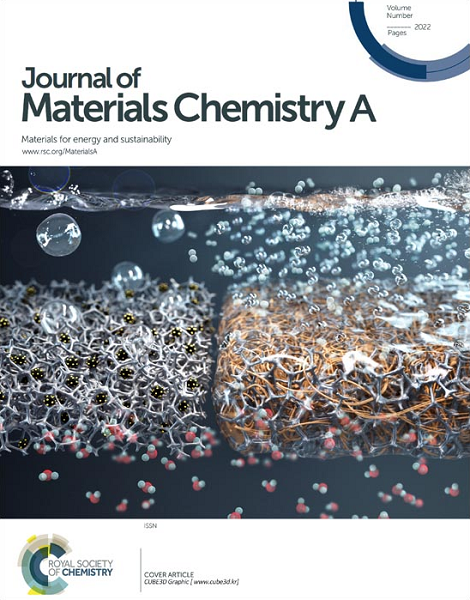速率决定阶跃后移通过多余电子转移到O-O反键轨道有效提高ORR性能
IF 10.7
2区 材料科学
Q1 CHEMISTRY, PHYSICAL
引用次数: 0
摘要
成功合成了厚度为1.33 nm,质量活性(MA)为6.78 a mgPGM-1的Pt23Pd77纳米片(NSs),其氧性能是商用Pt/C (0.15 a mgPt-1)的45.2倍。此外,与Pt/C (70.55 mV dec-1)相比,Pt23Pd77 NSs的Tafel斜率低至39.52 mV dec-1,表明速率决定步骤(RDS)从*OOH裂解转移到第二次电子转移。第一原理计算表明,*OOH→*O + *OH的势垒下降,因此第二次电子转移继承了RDS。在动力学控制区内,Pt/C的表观活化能(Ea)不随过电位的变化而变化,OH-的反应阶数接近于0,而NSs的表观活化能(Ea)随过电位的增大而减小,反应阶数为负。所有这些都证明了RDS是向后移动的。本文提出了另一种改进氧还原性能优化策略的思路,即动力学RDS倒移。本文章由计算机程序翻译,如有差异,请以英文原文为准。
Rate-determining Step Backshift Effectively Boost ORR Performance by Excess Electrons Transfer to O-O Antibonding Orbital
Pt23Pd77 nanosheets (NSs) were successfully synthesized with a thickness of 1.33 nm and the mass activity (MA) of 6.78 A mgPGM-1, achieving excellent oxygen performance of 45.2 times higher than commercial Pt/C (0.15 A mgPt-1). Furthermore, the Tafel slope of Pt23Pd77 NSs is as low as 39.52 mV dec-1 compared to Pt/C (70.55 mV dec-1) indicating the rate-determining step (RDS) is transferred from *OOH cleavage to the second electron transfer. First-principles calculations show a decline in the barrier of *OOH → *O + *OH, thus the second electron transfer succeeds the RDS. In the kinetic-controlled region, the apparent activation energy (Ea) of Pt/C does not change with the change of overpotential, and the reaction order of OH- is close to 0, while the Ea of the NSs decreases with the increase of overpotential, and the reaction order is negative. All of this proves that the RDS moves backwards. This paper provides another idea for improving the performance optimization strategy of oxygen reduction, that is, the kinetic RDS backshift.
求助全文
通过发布文献求助,成功后即可免费获取论文全文。
去求助
来源期刊

Journal of Materials Chemistry A
CHEMISTRY, PHYSICAL-ENERGY & FUELS
CiteScore
19.50
自引率
5.00%
发文量
1892
审稿时长
1.5 months
期刊介绍:
The Journal of Materials Chemistry A, B & C covers a wide range of high-quality studies in the field of materials chemistry, with each section focusing on specific applications of the materials studied. Journal of Materials Chemistry A emphasizes applications in energy and sustainability, including topics such as artificial photosynthesis, batteries, and fuel cells. Journal of Materials Chemistry B focuses on applications in biology and medicine, while Journal of Materials Chemistry C covers applications in optical, magnetic, and electronic devices. Example topic areas within the scope of Journal of Materials Chemistry A include catalysis, green/sustainable materials, sensors, and water treatment, among others.
 求助内容:
求助内容: 应助结果提醒方式:
应助结果提醒方式:


